大综合ACTION PLAN
09 行动计划Action plan

司与 课程名称、培训对象、总体目标 沟学 点状需求分析图,分出章节 通员 设计培训目标,每个章节1-2个目标 上 设计各目标内容大纲,使之满足以下条件:
1. 2. 3. 4.
能实现目标 遵循四步骤 过程生动 可操作
各章节排序,计算并调整学员/讲师的时间比 6. 每一个节一个PPT,完成教材设计
内部培训师培训 9-5
未来1-3个月内 行动计划
许盛华
内部培训师培训
1
行动计划-课程设计 (1个月)
按照“课程开发步骤”开发/完善一门课
注:如果是一个短时间的课程,则从“设计
培训目标”开始
教材中增加合适的
– 图片/视频 – 练习(角色扮演、情景模拟、案例分析、小
组讨论、试卷或实操演练)
内部培训师培训 9-2
行动计划-收集培训辅助材料 (3个月内)
真实案例 奇闻轶事 比喻、寓言、故事 游戏、小品 排比句、顺口溜 笑话、幽默图片、漫画 打油诗、对联
内部培训师培训 9-3
演练 (1个月内)
做一次培训 演练相关技巧
邀请公司人力资源部进行评估
内部培训师培训
9-4
附件:课程开发步骤
1. 2. 小 3. 课 4.
从 这 里 开 始 5.
action plan

1 floorplan (cradle manage)
2 coordination(cradle manage)
3 sales analysis(cradle manage)
4 inventory control(Rose manage)
二 Training
1 Arron /rose
2 lucy 3 simon 4 Tim
5 Marry/Orange
三 management
1 FR
2 SR
3 Inmage (Rose manage)
Action Plan(sep-oct)
1when we received the pics ,should be know if we can do 2check ALB list , if can change priority ,what we can do . 3 comunication with DT timely 1when show items must follow pictures ,Follow the standard by high demanding when change coordination and make picture to you to check the results 2 :Ranking is also very important like before, coordination changing must according to it, and keep best sellers in the best position. 3:According local customers' habit of dressing and weather situation to choose items 1 Format clearly 2 target ;sales analysis is push sales 3 summary ,to prepare for next week. 1Improve daily management(FR,Alarm report,the door,keepzoing ,greeting) 2inventory day control
action plan

Green Action PlanRecycling:1.Set up a “Green corner” with three boxes to recycle plastic bottles, batteries, new spapers and magazines.2. Make good use of each piece of paper in our notebooks.3.Collect stationary, such as notebooks, pens and textbo--ks to donate.4.Buy water bottles that can be used many times. Drink less bottled water.5. Use paper dictionaries more often.6.Collect waste water from our bottles in a pot to mop the floor.7. Use recycled paper.Environment/transportation/electricity:1.The last one to leave the classroom should make sure all pieces of electric equipm ent are turned off.2. When sunlight is enough, turn off the lights.3.Plant some flowers and green plants to make the air in our classroom fresh.4.Suggest all 10A students going to school on foot or by bike; try to take public transp ortations instead of cars when taking a long journey.5.Bring biodegradable bags to go shopping. Try not to use any plastic bags.6.Try to use less air conditioner. The temperature of the air conditioner should not be below 26 degrees Celsius.e less often mobiles phones, computers and other electric equipment to save e lectricity and reduce pollution.Society and Life:1. Eat more local fruits and vegetables; eat less meat. Reuse or recycle the disposable packaging.2. Choose to take a shower instead of a bath.3. Buy fewer new clothes. Wear clothes that are made of biodegradable materials. D onate old clothes to people who need them.4. Send E-mails to greet each other instead of using paper made postcards.5. Put up posters to invite all students in our school to join our action plan.6. Write articles about improving our city environment on our blogs to draw more attention from the society.。
Action Plan
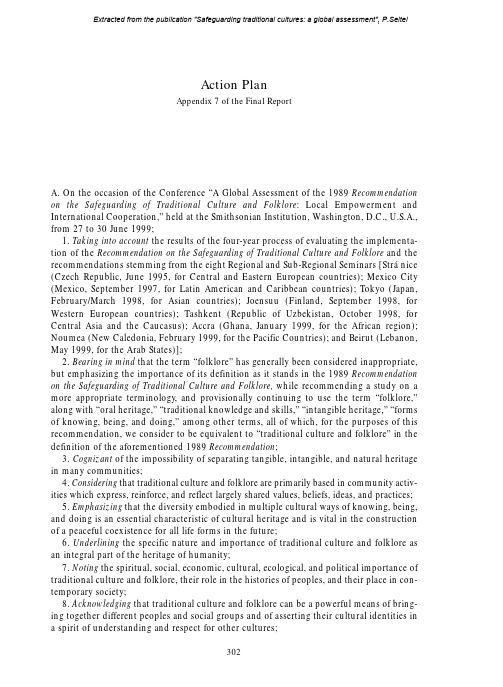
Action PlanAppendix 7 of the Final ReportA. On the occasion of the Conference “A Global Assessment of the 1989 Recommendation on the Safeguarding of T raditional Culture and Folklore: Local Empowerment and International Cooperation,” held at the Smithsonian Institution, Washington, D.C., U.S.A., from 27 to 30 June 1999;1. T aking into account the results of the four-year process of evaluating the implementa-tion of the Recommendation on the Safeguarding of T raditional Culture and Folklore and the recommendations stemming from the eight Regional and Sub-Regional Seminars [Stránice (Czech Republic, June 1995, for Central and Eastern European countries); Mexico City (Mexico, September 1997, for Latin American and Caribbean countries); Tokyo (Japan, February/March 1998, for Asian countries); Joensuu (Finland, September 1998, for Western European countries); Tashkent (Republic of Uzbekistan, October 1998, for Central Asia and the Caucasus); Accra (Ghana, January 1999, for the African region); Noumea (New Caledonia, February 1999, for the Pacific Countries); and Beirut (Lebanon, May 1999, for the Arab States)];2. Bearing in mind that the term “folklore” has generally been considered inappropriate, but emphasizing the importance of its definition as it stands in the 1989 Recommendation on the Safeguarding of T raditional Culture and Folklore, while recommending a study on a more appropriate terminology, and provisionally continuing to use the term “folklore,”along with “oral heritage,” “traditional knowledge and skills,” “intangible heritage,” “forms of knowing, being, and doing,” among other terms, all of which, for the purposes of this recommendation, we consider to be equivalent to “traditional culture and folklore” in the definition of the aforementioned 1989 Recommendation;3. Cognizant of the impossibility of separating tangible, intangible, and natural heritage in many communities;4. Considering that traditional culture and folklore are primarily based in community activ-ities which express, reinforce, and reflect largely shared values, beliefs, ideas, and practices;5. Emphasizing that the diversity embodied in multiple cultural ways of knowing, being, and doing is an essential characteristic of cultural heritage and is vital in the construction of a peaceful coexistence for all life forms in the future;6. Underlining the specific nature and importance of traditional culture and folklore as an integral part of the heritage of humanity;7. Noting the spiritual, social, economic, cultural, ecological, and political importance of traditional culture and folklore, their role in the histories of peoples, and their place in con-temporary society;8. Acknowledging that traditional culture and folklore can be a powerful means of bring-ing together different peoples and social groups and of asserting their cultural identities in a spirit of understanding and respect for other cultures;302Action Plan3039. Stressing the need in all countries for recognition of the role of traditional culture and folklore and the danger that practitioners face from multiple factors;10. Concerned with the fact that the well-being of community members and their prac-tices — whose strength and numbers are threatened daily by powerful forces such as war, forced displacement, intolerant ideologies and philosophies, environmental deterioration, socio-economic marginalization, and global commercialized culture — must be at the cen-ter of national and international cultural policy;11. T aking into account that traditional culture and folklore are dynamic and are often adapted through the innovative practices of community life;12. Recognizing that practitioners of traditional culture and folklore must be included to contribute expertise that is crucial to local, national, and international policy-making in such areas as health, environment, education, youth, gender, conflict resolution, the peace-ful coexistence of ethnic groups, sustainable human development, and inclusive civic par-ticipation as well as fighting chauvinism and intolerance;13. Deploring the exclusion of traditional groups from decision-making concerning the safeguarding of traditional culture and folklore;14. Acknowledging that states are comprised of cultural communities, that these com-munities and their folklore and beliefs often extend beyond state boundaries, and that indi-viduals may be members of more than one community;15. Recognizing that cultural interaction and exchange leads to the emergence of hybrid genres that reflect these cross-cultural exchanges;16. Recognizing that the preservation of traditional culture and folklore and the right to cultural self-determination in local communities should be consistent with current inter-national standards of human rights;17. Observing the important role that governments and non-governmental organizations can play in collaboration with tradition-bearers in the safeguarding of traditional culture and folklore and that they should act as quickly as possibleB. We, the participants in the Conference “A Global Assessment of the 1989 Recommendation on the Safeguarding of Traditional Culture and Folklore: Local Empowerment and International Cooperation,” recognize that the following measures need to be taken:1. develop legal and administrative instruments for protecting traditional communities— who create and nurture traditional culture and folklore — from poverty, exploita-tion, and marginalization;2. facilitate collaboration among communities, government and academic institutions,local and non-governmental organizations as well as private-sector organizations in order to address the issues facing traditional groups;3. ensure meaningful participation of traditional groups in decision-making processes inforums at all levels concerned with issues and policies that affect those groups;4. develop, in cooperation with communities, adequate education and training, includ-ing legal training, for their members and other cultural workers in understanding, pre-serving, and protecting traditional culture and folklore;5. develop programs that address the transnational nature of some traditional culture andfolklore;6. give special emphasis to programs that recognize, celebrate, and support women’s rolesin all aspects of their communities, which have been historically underrepresented, as contributors to traditional cultures and as field workers, scholars, and administrators;7. provide support for programs of cultural revitalization, particularly for groups dis-placed by war, famine, or natural disasters and other groups under threat of extinction;8. undertake measures to assist traditional groups, including legal assistance, in theirown efforts to improve their social status and economic well-being, which are essen-tial to their continued cultural practices.C. Specific Actions: On the basis of the aforementioned principles and needs, we recom-mend to the Governments of States that they:1. identify and support programs that encourage public recognition and validation of tra-ditional culture and folklore, continuing to support existing institutions and programs as well as establishing new ones where appropriate;2. institute and strengthen schemes for the comprehensive welfare of custodians andpractitioners of traditional cultures addressing issues such as housing, health care, and occupational hazards;3. nclude local knowledge in national forums that consider questions such as sustainablehuman development, globalization, environmental degradation, youth, education, and peaceful coexistence;4. facilitate and assist communities to develop their traditional material culture and workpractices in new contexts as efficient countermeasures to the destruction of the natu-ral environment and the devaluation of the dignity of human labor;5. provide cultural awareness training to workers in administrative, educational, andother institutions involved with traditional groups;6. facilitate access for members of traditional groups to relevant educational programsand, where necessary , facilitate the creation — with the community — of multipur-pose, community-based centers for education, documentation, and training;7. provide support to communities to preserve the active, creative use of local languagesin areas that include, but are not limited to, education, publishing, and public per-formance;8. provide support for the preservation of significant material culture and spaces that arecrucial to the transmission of traditional culture and folklore;9. support local, national, and international symposiums that bring together members oftraditional groups, representatives of non-governmental organizations, policy makers,and others to address issues facing traditional groups;10. identify , understand, encourage, and support traditional educational practices, espe-cially those relating to the very young;11. create a network of experts to assist local groups, cultural institutions, non-govern-mental organizations, and commercial organizations in the work of safeguarding tra-ditional culture, especially in areas such as education, tourism, law , and development;12. consider, if they so desire, the possible submission of a draft resolution to the UNESCOGeneral Conference requesting UNESCO to undertake a study on the feasibility of adopting a new normative instrument on the safeguarding of traditional culture and folklore;13. act in accordance with the obligations of States to protect the right to culture in Article27 of the International Covenant of Civil and Political Rights, by actively supporting communities in their practices of generation, transmission, authorization, and attribu-tion of traditional knowledge and skills in accordance with the wishes of the commu-nities, and in conformity with current international standards of human rights and consider taking steps, including, but not limited to, the following:Action Plan304i. adopting a legal scheme, according to which traditional knowledge can be made available by the community , in compliance with its wishes, for public use with a requirement of remuneration or other benefits in case of commercial use; and coop-erating to assure mutual recognition by all States of the effects of such schemes;ii. adopting a sui generis legal regime which would ensure protection• extending for the life of the community;• vested in the community , or in the individual and the community;• in accordance with traditional authorization and attribution procedures in thecommunity;• and establishing a body representing the community concerned and the relevantsectors of civil society to balance the competing interests of access and control iii.in awaiting adoption of a better protective scheme, encouraging modification anduse, in accordance with customary laws, of existing intellectual property regimes for the protection of traditional knowledge;iv .creating task forces to engage in further study of the following issues:content of “prior informed consent”; verification processes (burden of proof,modes of evidence codes); community intellectual rights vis a vis intellectual property rights; relationship to other instruments and Draft Documents (UN Draft Document, WIPO, TRIPS, CBD, Maatatu, SUVA and other Indigenous peoples’ declarations); questions of “rights” (authorship. moral, compensation);role of governments; problems of terminology (e.g., definitions and connota-tions of “folklore,” “popular culture,” etc.); alternative forms of compensation;promotion of case studies in relation to case law; legal mechanisms/documents specific to handicrafts, music, and other art forms; legal mechanisms applicable to knowledge collected prior to this instrument.We recommend that UNESCO:1. promote this Action Plan among its Member States by bringing this meeting to theattention of Member States;2. establish an international, interdisciplinary network of experts to assist Member Statesin developing, upon request, concrete programs in conformity with the principles of the present Action Plan;3. establish an international, interdisciplinary mobile working group of legal experts towork as advisors in collaboration with communities to develop suitable instruments for the protection of traditional culture and folklore;4. encourage the participation and, wherever necessary , the establishment of interna-tional non-governmental organizations with specialist expertise in particular areas of folklore and traditional knowledge to advise UNESCO on the protection of folklore and traditional knowledge;5. encourage international groups (scholars, cultural professionals, commercial organiza-tions, and legal bodies) to develop and adopt codes of ethics ensuring appropriate,respectful approaches to traditional culture and folklore6. accelerate the movement for the return of human remains and for repatriation of cultural heritage to assist the revitalization and self-perception of traditional cultures according to their own fundamental values;7. organize and support the formation of an international forum for the representation of Action Plan 305traditional communities’ concerns for safeguarding their own culture as well as regional and international symposiums that bring together members of traditional groups, representatives of non-governmental organizations, policy makers, and others to address issues facing traditional groups, such as women’s role in the safeguarding of traditional culture. Symposiums should be held in diverse locations, particularly out-side of First World nations — for example, in Yakutia;8.facilitate the application of new technologies in local, national, and regional docu-mentation centers through networks of collaboration and expertise, including local tradition-bearers;9.promote traditional culture and folklore on a global scale by such measures as pro-ducing regional festivals and declaring a World Day for Safeguarding Traditional Culture and Folklore;10.continue UNESCO’s collaboration with WIPO on issues of common interest;11. use UNESCO’s existing procedures to bring the possible adverse impact of actions onhuman rights, environment, food, agriculture, livelihood and industry , health and trade on culture to the attention of other UN bodies, such as FAO, WHO, UNICEF ,UNIFEM, and others as well as the WTO.Action Plan306。
Action Plan 活动计划

活动计划也可以用于其他的行为。
Review all key points
Method 培训方式
Training Steps 培训步骤
回顾所有的要点 Give an example to show what a good action plan is. 给学员展示一个好的活动计划书。(例子样本)
SHERATON SHENYANG LIDO HOTEL 沈阳丽都喜来登饭店 TRAINING ACTIVITY OUTLINE 培训活动纲要
Task: 任务: Action Plan 活动计划
Code 序号: OH-SM-RM-A201 Objectives: At the end of this session every trainee will be able to ensure sales Efforts are planned and directed against each key account and key prospect. 目的: 课程结束后每个学员能够独立完成对重要客户和有潜在生意客户的 活动计划。 Standard: 标准: Follow up S&P 参照标准和程序
Time 时间
8 minutes
Lecture 教学式
25 minutes All standard & Procedure be written in the flipchart 1 and showing to trainees: 在翻转展示板 1 上给学员展示服务标准与程序 1. Action Plans will require a minimum of two Valid Call Objectives in the next six months. Page 1 of 3
ActionPlan行动计划(Automotive汽车)
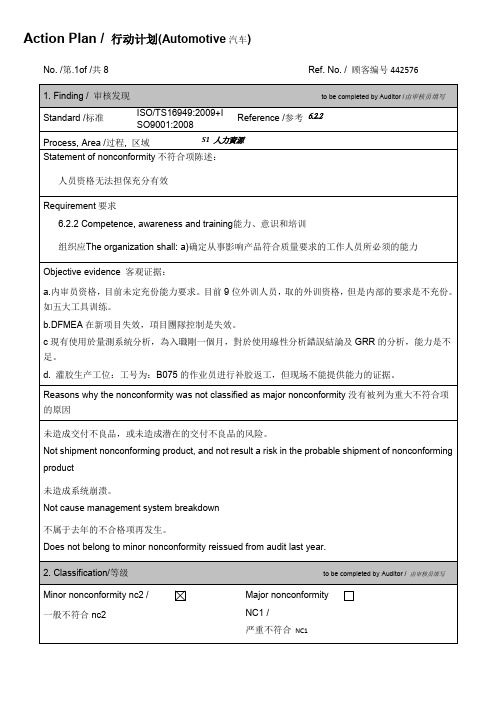
6.2.2
Process, Area /过程,区域
S1人力資源
Product design and development
Statement of nonconformity不符合项陈述:
人员资格无法担保充分有效
Requirement要求
6.2.2 Competence, awareness and training能力、意识和培训
Corrective actions have been implemented?整改是否完成?
yes /是no /否
Plan for closing is suitable; non conformity is 100% solved?关闭计划是合适的,不符合项是否100%解决?
Evidences for classification as 100% solved have to be attached
组织应The organization shall: a)确定从事影响产品符合质量要求的工作人员所必须的能力
Objective evidence客观证据:
a.内审员资格,目前未定充份能力要求。目前9位外训人员,取的外训资格,但是内部的要求是不充份。如五大工具训练。
b.DFMEA在新项目失效,項目團隊控制是失效。
a.修改QA1701内部品质稽核作业程序,制定内审员需要掌握的技能要求和标准要求,接受训练内容和老师资质要求。
b.聘请有资质的咨询公司老师,组织TS16949体系知识培训(包括五大工具)和内审员资格培训。
c.修改岗位工作说明书(工艺部)GA0103中工艺工程师的岗位技能要求:经过DFMEA、PFMEA培训
Type of follow up /
action plan 行动方案

action plan 行动方案
1. 目标确定:明确制定行动方案的目标,确保对整个过程有清晰的了解。
2. 问题分析:对当前问题进行详细的分析和评估,确定问题原因和影响范围。
3. 解决方案确定:根据问题的分析结果,确定最合适的解决方案。
可以通过头脑风暴、借鉴过去的经验或请专家提供建议来确定。
4. 行动计划制定:将解决方案转化为具体的行动计划。
确定各个环节的时间和资源安排,分配具体的责任人,确保整个过程的管理和控制。
5. 实施行动计划:执行制定的行动计划,确保按时完成工作任务,并监控整个过程是否按预期进行。
6. 评估行动效果:评估行动计划的实施效果,看是否达到了预期的目标。
根据评估结果做出相应的调整和改进。
7. 反馈和总结:收集反馈意见,总结经验教训,为未来的行动计划提供参考。
及时调整和改进行动计划。
8. 持续改进:将总结反馈的经验教训应用到以后的行动计划中,不断优化改进行动方案,提高制定行动方案的能力。
action plan 模板 -回复

action plan 模板-回复“action plan模板”是指为了实现某个目标而制定的一系列步骤或计划的模板。
在这篇文章中,我们将以“提高学习效率”为主题,给出一个1500-2000字的详细行动计划。
为了提高学习效率,我们可以按照以下步骤进行行动:第一步:设立明确的学习目标在开始学习之前,我们应该设立明确的学习目标,这将帮助我们更好地规划学习时间和安排学习内容。
学习目标应该具体、可衡量,并与课程或学科的目标一致。
例如,我们可以设立一个目标,比如每周完成指定的课程内容,并在每次考试中取得优异的成绩。
第二步:制定学习计划制定学习计划是提高学习效率的关键。
我们可以按照学习目标,将学习内容分解成小的任务,并安排每天或每周的学习时间表。
合理安排学习时间,避免拖延和浪费时间,同时确保学习任务得到适当分配和完成。
第三步:创造一个适合学习的环境学习环境对提高学习效率有着巨大影响。
我们应该选择一个安静、整洁、明亮的地方进行学习,远离干扰和噪音。
同时,确保有足够的书籍、参考资料和学习工具,为学习提供必要的支持。
第四步:有效利用学习工具现代科技为学习提供了极大的便利。
我们应该充分利用学习工具,如电脑、平板和智能手机等,来获取资料、参与在线课程和进行自主学习。
同时,我们也要学会合理使用学习应用和软件,如备忘录、时间管理工具和学习记录器等,提高学习效率。
第五步:采用有效的学习方法学习方法对学习效果有着直接影响。
我们应该采用一些有效的学习方法,如主动阅读、主动思考和主动复习等。
主动学习可以帮助我们更好地理解和吸收知识,同时也提高学习效率和学习质量。
第六步:培养良好的学习习惯良好的学习习惯是提高学习效率的关键。
我们应该养成良好的时间管理习惯,合理安排学习时间,充分利用碎片时间进行学习;同时,养成良好的阅读习惯和学习笔记习惯,可以帮助我们更好地整理和巩固学习内容。
第七步:拓宽学习资源和渠道学习资源和渠道的拓宽可以为我们提供更多的学习机会和资源。
action plan 模板 -回复
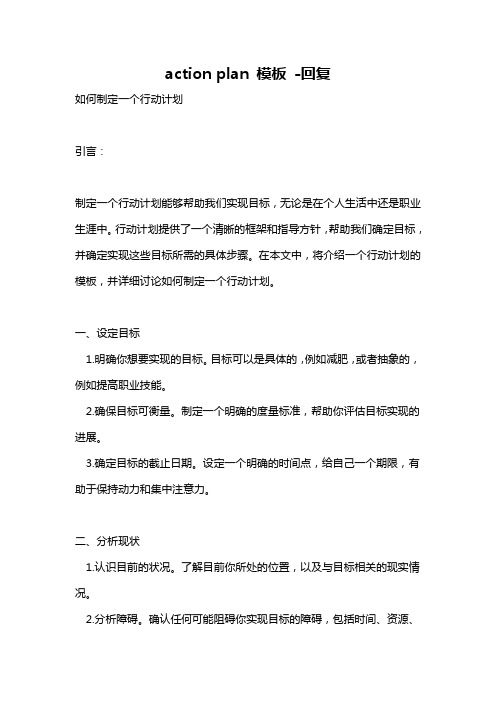
action plan 模板-回复如何制定一个行动计划引言:制定一个行动计划能够帮助我们实现目标,无论是在个人生活中还是职业生涯中。
行动计划提供了一个清晰的框架和指导方针,帮助我们确定目标,并确定实现这些目标所需的具体步骤。
在本文中,将介绍一个行动计划的模板,并详细讨论如何制定一个行动计划。
一、设定目标1.明确你想要实现的目标。
目标可以是具体的,例如减肥,或者抽象的,例如提高职业技能。
2.确保目标可衡量。
制定一个明确的度量标准,帮助你评估目标实现的进展。
3.确定目标的截止日期。
设定一个明确的时间点,给自己一个期限,有助于保持动力和集中注意力。
二、分析现状1.认识目前的状况。
了解目前你所处的位置,以及与目标相关的现实情况。
2.分析障碍。
确认任何可能阻碍你实现目标的障碍,包括时间、资源、技能或其他因素。
3.识别优势。
识别你在实现目标方面的优势,例如特定的技能、知识或支持网络。
三、制定行动计划1.确定关键步骤。
列出实现目标所需的具体步骤。
确保这些步骤明确、可行,并且按照逻辑顺序排列。
2.设定优先级。
根据步骤的重要性和紧迫性,确定优先级顺序。
这有助于有效地管理时间和资源。
3.分配时间和资源。
为每个步骤分配适当的时间和资源。
这可以帮助你更好地规划和控制任务。
四、跟踪和评估1.制定跟踪机制。
确定一个方法来跟踪你的进展。
这可以是通过记录日志、制定图表或使用应用程序等方式。
2.定期评估。
定期评估你的进展,比较实际情况与目标要求。
这有助于你了解是否需要进行调整或制定新的措施。
3.调整计划。
根据评估结果,适时地进行调整。
根据实际情况,重新安排优先级、重新分配资源或修改目标。
五、保持积极态度和坚定决心1.保持积极态度。
保持积极的思维,相信自己能够实现目标。
积极的态度有助于推动你迈向成功。
2.坚定决心。
坚持不懈地追求目标,即使遇到困难或挫折。
决心和毅力是取得成功的重要品质。
结论:制定一个行动计划是实现目标的重要步骤。
通过设定目标,分析现状,制定行动计划,跟踪和评估,并保持积极态度和坚定决心,我们可以增加成功的机会。
综合工作计划

综合工作计划有关综合工作计划汇编5篇时光在流逝,从不停歇,我们的工作又进入新的阶段,为了今后更好的工作发展,让我们一起来学习写计划吧。
可是到底什么样的计划才是适合自己的呢?下面是小编为大家收集的综合工作计划5篇,希望能够帮助到大家。
综合工作计划篇1为完善工作作风,提升企业品牌。
20xx年公司综合办公室以提升素质,强化服务为宗旨,紧紧围绕公司的中心工作,狠抓工作作风和工作质量,努力争创学习型科室、服务型科室。
为保证年度各项工作顺利完成,制定综合办公室工作计划如下:一、党建工作计划1、积极做好入党积极分子的培养工作,为党组织培养后备力量。
每个支部至少2名。
2、做好党员发展对象的推荐、测评、培养、政审等工作,完成全年党员发展计划。
3、进一步完善基层党支部考核标准和考核办法,保证党建工作再上新台阶。
4、抓好党校建设,做好党员培训工作。
5、“七、一”期间开展一次以歌颂党、弘扬企业文化为主题的大型活动。
6、制定方案,开展好“党员先锋岗”活动。
二、宣传工作计划1、理顺公司宣传报道网络,加强领导和管理,使宣传内容更加丰富,贴近员工,提升《XX新闻》的水平。
2、结合公司实际,强化公司形象宣传工作。
重点理顺公司内部的标语、宣传口号、标牌、宣传栏、公告栏等使用公司统一色、统一尺寸等。
3、通过专业协会和其他媒体等渠道做好产品、小学教科室工作计划企业形象宣传工作。
4、配合公司其他部门做好宣传报道工作如:公司重大活动、题材的新闻报道策划;联络、接洽公司外新闻单位来公司采访、选材;归口管理各部门对外宣传报道的宣传口径等。
三、群团工作计划1、制定计划措施,以抓好基层组织建设为突破口,使工会、共青团、妇女工作上一个新台阶。
2、“五、一”、“五、四”、“十、一”期间各组织一次丰富多彩的文体活动。
3、结合公司生产经营工作实际,制定方案,深入开展“岗位练兵”、“岗位先锋”等活动,做到覆盖面广,效果显著。
四、20xx年安全工作计划1、从进一步完善公司安全保卫工作制度入手,结合公司实际,在组织好研究、探讨的基础上,成立公司治安保卫大队,健全、完善公司安全保卫系统。
stretch reconciliation action plan 行动计划

stretch reconciliation action plan 行动计划为了确保为了确保stretch reconciliation行动计划的成功实施,我们需要制定一份详细的行动计划。
stretch reconciliation行动计划的成功实施,我们需要制定一个详细的行动计划。
该计划将明确目标、时间安排、资源分配、责任人以及风险管理等方面的内容。
以下是一个可能的行动计划:1. 确定目标:首先,我们需要明确stretch reconciliation的目标,例如提高企业的财务透明度、减少差异、提高报告质量等。
这将有助于我们制定具体的行动步骤和衡量成功的方法。
以下是一个可能的行动计划示例:一、目标该行动计划的目标是通过stretch reconciliation,优化公司的业务流程,提高效率和准确性,并确保数据的完整性和一致性。
2. 评估现状:我们需要评估企业当前的reconciliation状况,包括现有的流程、工具、人员能力和数据质量等方面。
二、时间安排1. 阶段一(X年X月-X年X月):确定需要优化的业务流程和相关数据,以及这将帮助我们识别存在的问题和改进的机会。
制定详细的实施计划。
2. 阶段二(X年X月-X年X月):开发并测试stretch reconciliation 系统,确保其功能和性能符合3. 制定行动步骤:根据目标和现状评估结果,我们可以制定具体的行动步骤,例如改进流程、引入新的工具、培训人员、预期。
数据清洗等。
这些步骤应该具有明确的责任人、时间安排和完成标准。
3. 阶段三(X年X月-X年X月):全面部署stretch reconciliation 系统,并进行必要的培训和推广。
4. 监控和调整:在实施行动计划的过程中,我们需要持续监控各项行动的进展情况,并及时调整计划以适应变化。
我们还需要定期审查计划的效果,确保实现预定的目标。
4. 阶段四(X年X月-X年X月):持续优化和改进stretch reconciliation系统,并根据实际运行情况进行调整和改进。
最新action_plan_template

Dependencies, Risks, and Constraints:
Estimated Completion Date for All Activities:
Action Items for
Action Item Number:Owner:Due Date:
Action Plan for
version 1.0 draft1
Project:Date:
Goals:
Measures of Success:
Scope of Organizational Impact:
Staffing and Participants:
Name
Role
Time Commitment
Description of Activity:
Deliverable(s):
Resources Needed:
Action Plan Tracking for
Action Item Number
Date Started
Date Completed
Comments
Deliverable(s):
Resources Needed:
Action Item Number:Owner:Due Date:
Description of Activity:
Deliverable(s):
ResourOwner:Due Date:
Description of Activity:
Deliverable(s):
Resources Needed:
Action Items forError! Bookmark not defined.
ActionPlanv1
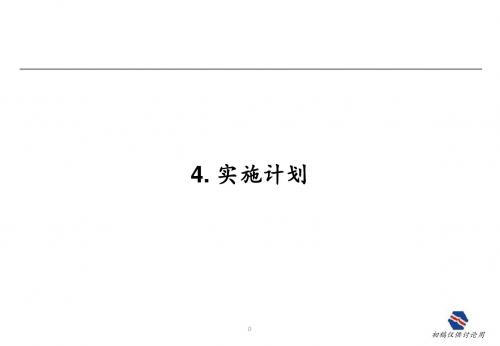
• 与战略联盟成员进行项目开发合 作
•股份研发中心/ 战略规划部
•股份研发中心/ 战略规划部
•股份研发中心/ 战略规划部
起止日期
• 2000年12月至1月
• 2019年1月至2019 年12月
18
初稿仅供讨论用
优化业务投资组合
子目标
• 完成传输设备业 务流程优化设计
• 制定招聘计划并制定下岗员工 安置计划
负责人
• 股份生产副总裁 • 股份市场部
• 股份投资管理部 • 股份财务部 • 股份基础元器件部 • 股份基础元器件部
起止日期
• 2000年11月至 2000年12月
• 2000年11月
7
初稿仅供讨论用
优化业务投资组合
子目标
• 完成智能卡投 资和业务流程 重组
• 拓展全球定位系 统及地理信息业 务
主要任务
• GPS车载防盗系统上市
• 建立与主要汽车生产商的合作, 建立GPS车载防盗系统的捆绑销 售
• 评估与三吉及赛格合作的可行性, 包括双方的价值所在、参与联盟 的意愿、双方企业文化整合的能 力等
• 建立与三吉或赛格的合作,包括 营销合作或项目研发合作
• 完成电子地图与手机产品的结合 应用并推出相关产品
• 开拓与国家测绘局的合作,获取 并开发新的图源
• 建立与其他手机厂商合作,进行 合作研发及捆绑销售
• 股份软件部 • 股份软件部/市场部
• 股份软件部 • 股份软件部 • 股份软件部
• 2000年11月至 2000年12月
• 2019年1月至2019 年12月
13
初稿仅供讨论用
优化业务投资组合
action plan范文

action plan范文行动计划:提高个人健康水平引言:在现代社会中,个人的健康水平对于身心健康以及生活质量有着重要的影响。
为了改善个人的健康状况,制定一个行动计划是至关重要的。
本文将提出一份行动计划,以帮助个人提高自身的健康水平。
一、饮食方面1.营养均衡:确保每天摄入适量的蔬菜、水果、谷物和蛋白质,以获得身体所需的各种营养物质。
2.控制食量:合理控制每餐的食量,避免暴饮暴食,以维持健康的体重。
3.减少加工食品:尽量减少摄入加工食品,选择新鲜食材,以避免摄入过多的盐、糖和添加剂。
二、运动方面1.每日锻炼:每天坚持进行适量的运动,如散步、跑步或健身操等,以增强心肺功能和身体的灵活性。
2.多样化运动:选择多种不同的运动方式,如游泳、瑜伽或篮球等,以锻炼全身的肌肉群。
3.定期休息:避免过度运动,确保适当的休息时间,以防止过度疲劳和运动损伤。
三、心理健康1.保持良好的心态:积极面对生活中的挑战和压力,培养积极的心态,以保持良好的心理健康。
2.寻求支持:与家人、朋友或专业心理咨询师交流,寻求适当的支持和建议,以帮助应对压力和情绪问题。
3.培养爱好:参与自己感兴趣的活动和爱好,如阅读、绘画或音乐等,以促进心理放松和愉悦感。
四、睡眠质量1.规律作息:保持规律的作息时间,每天早睡早起,保证充足的睡眠时间。
2.舒适环境:创造一个安静、舒适的睡眠环境,如调整室温、选择舒适的床垫和枕头等。
3.放松活动:在睡前进行放松活动,如冥想、听音乐或泡个热水澡等,以帮助入睡。
五、定期体检1.定期体检:每年进行一次全面的体检,以及时发现和预防潜在的健康问题。
2.遵医嘱:按照医生的建议进行治疗和药物管理,以保持身体的健康状态。
结论:通过制定这份行动计划,个人可以有效地提高自身的健康水平。
然而,行动计划只有在坚持和执行的基础上才能产生实际效果。
因此,个人需要根据自身情况制定具体的实施计划,并始终坚持下去。
通过良好的饮食习惯、适量的运动、健康的心理状态和良好的睡眠质量,个人将能够达到更高水平的健康和幸福。
学习目标 — 行动计划(Action Plan)

活动目标:通过成就、实物、精神等3类的目标达成后的收获,让孩子学会描述成功。
从而为完成目标而努力。
我的学习风格
我喜欢的学习方式
我的新知识来自于我喜欢的活动形式应该有自 学和小伙伴一起学习学习小组读 书听/看别人讲动手实践
我的学习风格
1、当我有问题的时候,我喜欢问老师
2、我喜欢和同学或小伙伴分享我的学习成果
3、我喜欢写作
4、我喜欢看书
5、我喜欢做各种练习册
6、你还喜欢分享其他内容吗?
行动计划思维导图
活动目标:利用思维导图发散梳理为了达到目标可以做的工作。
你需要:给自己设定一个的目标。
将对目标有帮助的工作写在箭头中。
而对完成目标没有帮助的可以写在箭头外面。
我想为了达到目标
我可以
我这样做是无法达到目标的:为了达到目标,我会:。
Action_plan_on_standardization_talent_cultivation_
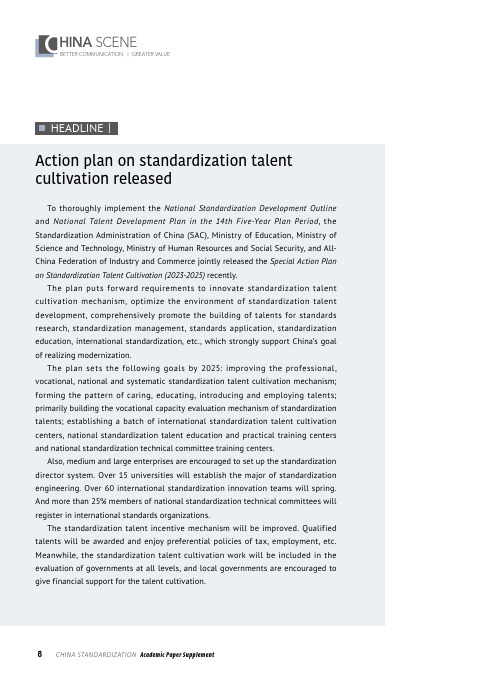
HINA SCENEBETTER COMMUNICATION | GREATER VALUETo thoroughly implement the National Standardization Development Outline and National Talent Development Plan in the 14th Five-Year Plan Period , the Standardization Administration of China (SAC), Ministry of Education, Ministry of Science and Technology, Ministry of Human Resources and Social Security, and All-China Federation of Industry and Commerce jointly released the Special Action Plan on Standardization Talent Cultivation (2023-2025) recently.The plan puts forward requirements to innovate standardization talent cultivation mechanism, optimize the environment of standardization talent development, comprehensively promote the building of talents for standards research, standardization management, standards application, standardization education, international standardization, etc., which strongly support China’s goal of realizing modernization.The plan sets the following goals by 2025: improving the professional, vocational, national and systematic standardization talent cultivation mechanism; forming the pattern of caring, educating, introducing and employing talents; primarily building the vocational capacity evaluation mechanism of standardization talents; establishing a batch of international standardization talent cultivation centers, national standardization talent education and practical training centers and national standardization technical committee training centers.Also, medium and large enterprises are encouraged to set up the standardization director system. Over 15 universities will establish the major of standardization engineering. Over 60 international standardization innovation teams will spring. And more than 25% members of national standardization technical committees will register in international standards organizations.The standardization talent incentive mechanism will be improved. Qualified talents will be awarded and enjoy preferential policies of tax, employment, etc. Meanwhile, the standardization talent cultivation work will be included in the evaluation of governments at all levels, and local governments are encouraged to give financial support for the talent cultivation.Action plan on standardization talent cultivation released8 CHINA STANDARDIZATION Academic Paper Supplement。
actionplan范文
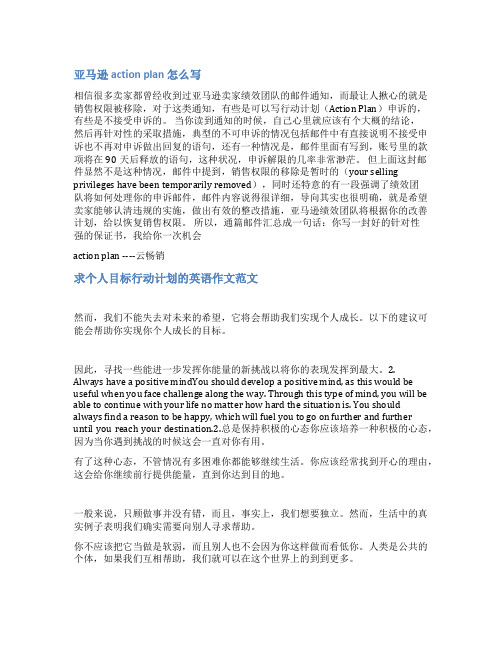
亚马逊action plan 怎么写相信很多卖家都曾经收到过亚马逊卖家绩效团队的邮件通知,而最让人揪心的就是销售权限被移除,对于这类通知,有些是可以写行动计划(Action Plan)申诉的,有些是不接受申诉的。
当你读到通知的时候,自己心里就应该有个大概的结论,然后再针对性的采取措施,典型的不可申诉的情况包括邮件中有直接说明不接受申诉也不再对申诉做出回复的语句,还有一种情况是,邮件里面有写到,账号里的款项将在90天后释放的语句,这种状况,申诉解限的几率非常渺茫。
但上面这封邮件显然不是这种情况,邮件中提到,销售权限的移除是暂时的(your selling privileges have been temporarily removed),同时还特意的有一段强调了绩效团队将如何处理你的申诉邮件,邮件内容说得很详细,导向其实也很明确,就是希望卖家能够认清违规的实施,做出有效的整改措施,亚马逊绩效团队将根据你的改善计划,给以恢复销售权限。
所以,通篇邮件汇总成一句话:你写一封好的针对性强的保证书,我给你一次机会action plan ----云畅销求个人目标行动计划的英语作文范文然而,我们不能失去对未来的希望,它将会帮助我们实现个人成长。
以下的建议可能会帮助你实现你个人成长的目标。
因此,寻找一些能进一步发挥你能量的新挑战以将你的表现发挥到最大。
2. Always have a positive mindYou should develop a positive mind, as this would be useful when you face challenge along the way. Through this type of mind, you will be able to continue with your life no matter how hard the situation is. You should always find a reason to be happy, which will fuel you to go on further and further until you reach your destination.2.总是保持积极的心态你应该培养一种积极的心态,因为当你遇到挑战的时候这会一直对你有用。
- 1、下载文档前请自行甄别文档内容的完整性,平台不提供额外的编辑、内容补充、找答案等附加服务。
- 2、"仅部分预览"的文档,不可在线预览部分如存在完整性等问题,可反馈申请退款(可完整预览的文档不适用该条件!)。
- 3、如文档侵犯您的权益,请联系客服反馈,我们会尽快为您处理(人工客服工作时间:9:00-18:30)。
Action plan1.1. IntroductionI am assigned to the Cadogan Bank plc.as an Ivestment Services Manager. I am now asked to the consider the prividing solutions to Alexander Flynn who has referred from the Bank’s Western Branch. The couple have 3 children in different ages, I will considerAbout their saving for the education and raising for children, they also have an outstanding mortgage on the property, and Alexander want secured against his previous family home. so he need an alternative methods of borrowing on their property.and protecting for Alexander and Janet also is necessary. I would be concern about the suitable saving products the privide.This report would be divided into 3 steps: planning, developing, evaluation.1.2. Likely resources to be usedAll most the informations on this report were lookuped from the Internet,The fact that the Internet is operational at all times makes it the most efficient business machine to date.In the report preparing stage, I can fiand financial products and institution rundly.Utilizing the Internet to obtain the Detailed information of the bank and insurance institution. The bank of Internet is usually accessible 24 hours per day. So I can use it to speed up communication and decision-making (for choose Financial products) at any time. Traditional methods of performing surveys are often relatively slow and expensive compared to online surveys conducted on the Internet which is combined with the situation of Alexander’ family.in order to fill out various needs of customers or what they would like to see in a future product. it's often necessary to compile a list of address and make a announcements, Because there is virtually no time lag from the time it takes to publish information to making the information available to users.In order to present the complete material, I have a group disscusion, every groupmember have various kinds of way to collect the information with different medium, so we can disscus with team mates to syuthesize some peachy idea.simply put:•Ideas can be generated.•Ideas can be shared.•Ideas can be 'tried out'.•Ideas can be responded to by others.Some other resources I can find from concerning brochure, or consulting tutor, visiting prociser is a immediate choise if I have enough time to go abroad.1.3. Strategy for carring out reportFirst of all, I analysised the case which give us some basic information about Financialsituation of Alexander’s, I would be formulate a financing plan in cinnecting with personal information. And then I will make to do list and fix a time schedule accordingly. The action plan should be prepared, In order to let the report more coherent.On the developing stage , I will find the sources of information through the internet, and the likely financial needs of the clients would be: saving borrowing and insurance. According to the plan, finding the suitable suppliers and compare with the recommend products for Alexander’family should be prudently. I can write the case study report after selected the products. And then I need to review the reach process and motify some mistakes.After all of it, changes made during project compared to original action plan.1.4. How the project will be managedAfter analysis the cases, this project report could take the following format: Planning—action planI will make the time distrubution in this process, and collecting likely resources which would be used. Expecially how the project will be project.Developing –write the reportI will find the likely financial needs of the clients: savings, mortgage needs, protection needs. moreover, I will help them to choose suitable products. I am now haply know the situation about the fimaly of Alexander. I perform detailed analysis of the client's specific needs and recommend appropriate solutions.providing risk solutions to Alexander and Janet. And deal with all major insurers, saving products or alternative methods of borrowing.I will establish a series of financial plans:Suitable saving products that provide:I am consider about AER which have best return s in interest, and NS&I operated by HM treasury that are the most attractive feature;Protection for them:protection for Alexander and Janet against, with a view to health problems, I recommend to take out CII for Alexander.Borrowing on their property:And alternative methods of borrowing on their property, Alexander was underfunded to set up his company, so I suggest to use APR to remortage.EvaluationThis the last step of the report.during this project, I will compared to the original plan.All of the information about the financial service product would be backup to the u card avoid lose, or create some floder on the computer which can be named as ―saving/borrowing/protect products information‖.1.5. Time scales for project1.6. Sources of informationMost of information are derived from the text books and websit. From these books I can find the matching products for Alexander’ family:<personal financial services><financial sector:an introduction><principles of insurance>Internet also has unlimited resources for my reference, such as wikipia, google.and I can exchange ideas on the BBS with the insiders.。
